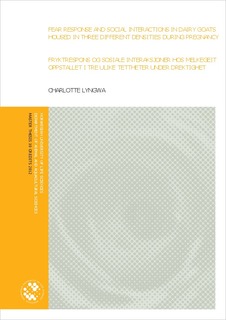| dc.contributor.author | Lyngwa, Charlotte | |
| dc.date.accessioned | 2012-09-06T10:33:45Z | |
| dc.date.available | 2012-09-06T10:33:45Z | |
| dc.date.copyright | 2012 | |
| dc.date.issued | 2012-09-06 | |
| dc.identifier.uri | http://hdl.handle.net/11250/186119 | |
| dc.description.abstract | Farm animals are social and are willing to work for access to social companions. To separate and isolate animals from each other is a strong stressor, and will induce fear. The fear of novel and fear-eliciting situations in social animals can be reduced by being a part of a group. The response to handling will probably not only be a reaction to humans, but will also be affected by the environment, the novelty of the situation and the social context. The aim of this project was firstly to study the effect of three different densities (1 m2, 2 m2 and 3 m2) on fear responses and social behaviour in a separation test and human approach test. Secondly we wanted to study the relationship between fear responses and different types of social interactions on the individual level. Fifty four pregnant goats were selected and used in this study. They were housed in three different densities with three groups in each density. Each of the groups consisted of six goats. The separation test lasted for two minutes were vocalizations and flight attempts were recorded. The human approach test was performed right after the separation test. The scores from this test were used to determine the individuals reactivity. A human entered the pen, took one big step to the left or right and waited for five second before approaching the goat. When the animal was within reach the goat was given the opportunity to smell the hand of the human. The human would then crouch together and hold this position for 10 seconds.
We predicted higher levels of vocalization and flight attempts in the second separation test in the high density. Our findings could not support this prediction. Number of vocalizations was significantly higher in the second separation test, but had no effect of density. Number of flight attempts was not affected by densities, but there was a significant difference between the two tests. We predicted that confidence score in the human approach test were affected by density. The results could not support this prediction. As predicted, the results showed a higher level of offensive initiated behaviours in the high level density than in lower densities. It will be difficult to make any conclusion about the level of fear in these tests since they go in different directions. The density had an effect on the number of offensive behaviour initiated and received. These results give us a clear indication that high densities give higher aggression among goats. | no_NO |
| dc.language.iso | eng | no_NO |
| dc.publisher | Norwegian University of Life Sciences, Ås | |
| dc.subject | Goat | no_NO |
| dc.subject | animal density | no_NO |
| dc.subject | fear | no_NO |
| dc.subject | social interactions | no_NO |
| dc.subject | human approach | no_NO |
| dc.subject | isolation test | no_NO |
| dc.subject | separation test | no_NO |
| dc.title | Fear response and social interactions in dairy goat housed in three different densities during pregnancy | no_NO |
| dc.title.alternative | Fryktrespons og sosial interaksjoner hos melkegeit oppstallet i tre ulike tettheter under drektighet | no_NO |
| dc.type | Master thesis | no_NO |
| dc.subject.nsi | VDP::Agriculture and fishery disciplines: 900::Agriculture disciplines: 910::Livestock breeding, rearing, reproduction: 912 | no_NO |
| dc.source.pagenumber | 48 | no_NO |
